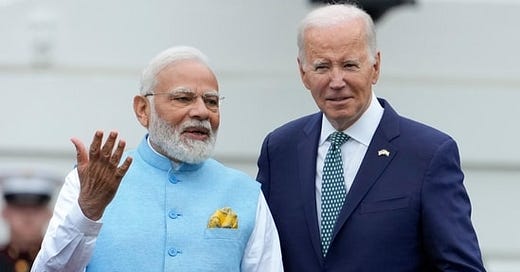Special Edition: Chinese Analysts & Media on India-US Ties and India-China Ties after Modi's US Visit
Dear subscribers,
As promised, below is a breakdown of some of the analyses offered by Chinese scholars and media following Indian Prime Minister Narendra Modi’s visit to the US. I’ll try and do more such weekend pieces going forward for paid subscribers. So please do upgrade to a paid subscription if you are interested in getting these. Of course, what you get in addition is my deep gratitude.
Anyway, some observations based on these pieces:
The primary narrative in all of these articles is about emphasising differences between India and US. As much as the pieces are indicative of Beijing’s anxieties, the articles also tend to paint India-US ties as more a matter of convenience owing to current geopolitical currents and a momentary convergence of interests. Regardless, there is a sense of concern that the deepening India-US relationship will result in multiple complications for China.
A convergence of interests is very different from shared interests. This comes across rather strongly in all the pieces. A common argument is that while the US is seeking to draw India into its orbit to contain China, India is engaging with the US to further its own rise. This, these analysts argue, indicate that sooner rather than later, frictions will emerge and even potentially grow intense.
Some of the articles highlight that despite all the agreements inked during the visit, there are likely to be significant structural and practical challenges when it comes to implementing them.
What is also fascinating in the articles is the increased reference to India as a major power. This is very different from the designation of India in the official hierarchy. In that, the major power reference is reserved for the US, EU and Russia. It will be worth watching whether this trend of discussing India as a major power persists in analytical and scholarly circles and whether it finds its way in official discourse. One note of caution here is that for Chinese analysts whose career focus is to study India, there is obviously an interest in raising India’s profile as a major power. So let’s wait and see what happens with official discourse.
Of course, as expected, the pieces do contain a variety of veiled threats and subversive messaging. These include statements like China is close to India while the US is far; the threat of “countermeasures” for Indian policies with regard to Chinese companies; stoking fears that the US simply wants to exacerbate India-China tensions and will eventually turn on India too; and arguing that India will not likely assist the US as it expects in the case of a Taiwan contingency.
Finally, based on these pieces, one can conclude that we are entering a new phase of China-India competition in the Global South/developing world. At least, the pieces below seem to view India as desiring to emerge as the leader of the ‘Global South’. One analyst, in fact, argues that India lost this status after the 1962 war.
Clearly, we are in for some interesting times. Below are the translated summaries of the articles.
Cheers,
Manoj




